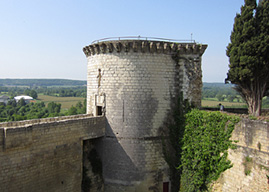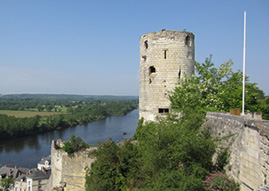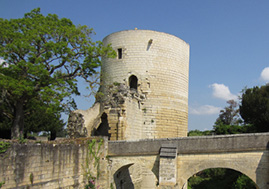Chinon Castle France Detailed Description contd.
2: FORT COUDRAY AT CHINON CASTLE
The Boissy Tower
 It was during the 13th century that the Boissy tower was constructed probably during the time of Saint Louis (Louis IX). Its name comes from the Lords of Boissy who were governors of the castle of Chinon in the 16th century. From this tower one can get a wonderfully clear view of the valley and there was probably originally a chapel on the first floor framed by the elegantly sculpted arches that one can see today. There is a guardroom on the ground floor in which one can see loopholes (arrow slits) that keep watch over the valley and the Coudray moat. The stairway allows access to the terrace from which one can get to the Coudray tower by a walkway. During the early 15th century, the tower was made to connect with the Royal quarters via a walkway and through another gate preceded by a footbridge. Click photos to enlarge
It was during the 13th century that the Boissy tower was constructed probably during the time of Saint Louis (Louis IX). Its name comes from the Lords of Boissy who were governors of the castle of Chinon in the 16th century. From this tower one can get a wonderfully clear view of the valley and there was probably originally a chapel on the first floor framed by the elegantly sculpted arches that one can see today. There is a guardroom on the ground floor in which one can see loopholes (arrow slits) that keep watch over the valley and the Coudray moat. The stairway allows access to the terrace from which one can get to the Coudray tower by a walkway. During the early 15th century, the tower was made to connect with the Royal quarters via a walkway and through another gate preceded by a footbridge. Click photos to enlarge
The Mill Tower
 This tower dates back to the days of King John and is a prime example of military architecture. It was built in the 12 century and is one of the main features of Fort Coudray although the ground floor with its polygonal plan and segmented domed roof is of a style very rarely found in Plantagenet castles. The Mill Tower gets his name due to the Windmill perched on its summit – a recent addition. This tower has a perimeter wall protecting its lower part and this is the only example is this on the site. The tower is entered at ground floor level from Fort Coudray but this level is not connected to the first floor which is accessible only by a walkway the top floor is a perfect lookout post featuring six large windows and access to this law is by a staircase built into the thick wall.
This tower dates back to the days of King John and is a prime example of military architecture. It was built in the 12 century and is one of the main features of Fort Coudray although the ground floor with its polygonal plan and segmented domed roof is of a style very rarely found in Plantagenet castles. The Mill Tower gets his name due to the Windmill perched on its summit – a recent addition. This tower has a perimeter wall protecting its lower part and this is the only example is this on the site. The tower is entered at ground floor level from Fort Coudray but this level is not connected to the first floor which is accessible only by a walkway the top floor is a perfect lookout post featuring six large windows and access to this law is by a staircase built into the thick wall.
The Coudray Tower
 The Coudray tower was created by Philippe Augustus during his renovations after he recaptured the fortress in 1205. This fine medieval donjon overlooks the Mill Tower which was constructed by his enemy King John. The medieval name of the tower is probably due to the presence of the grove of hazelnut trees "coudres" found inside the Fort. A door with a drawbridge and portcullis flanks the tower securing Fort Coudray. There remains three levels which will feature loopholes the first two being covered with a Gothic vault. There is a trap or dropbox which protects access to the door on the second floor. There is a tunnel entrance in the lower room which in the event of a siege would allow occupants to escape. The Coudray tower was used as a prison for dignitaries of the Order of the Temple in 1308. Joan of Arc was also a guest there 1429.
The Coudray tower was created by Philippe Augustus during his renovations after he recaptured the fortress in 1205. This fine medieval donjon overlooks the Mill Tower which was constructed by his enemy King John. The medieval name of the tower is probably due to the presence of the grove of hazelnut trees "coudres" found inside the Fort. A door with a drawbridge and portcullis flanks the tower securing Fort Coudray. There remains three levels which will feature loopholes the first two being covered with a Gothic vault. There is a trap or dropbox which protects access to the door on the second floor. There is a tunnel entrance in the lower room which in the event of a siege would allow occupants to escape. The Coudray tower was used as a prison for dignitaries of the Order of the Temple in 1308. Joan of Arc was also a guest there 1429.
3: FORT SAINT GEORGE
Fort Saint George
 Around the year 1160, King Henry II Plantagenet decided to add new buildings to the East of the old fortress which he had inherited from his ancestors. This was to be in the form of a palace without any particular military purpose which would be used for the administration of his lands and for him to hold court when in residence at Chinon. Many years later, King John, Henry's youngest son who had come to the throne after the untimely death of Richard the Lionheart, strengthened the defences of the castle mainly due to the threat which came from his rival King Philippe Augustus of France. To this end he fortified Fort St George making it an outpost which would protect the main castle from the approach road from Tours. Today Fort St George houses the new reception hall for the fortress.
Around the year 1160, King Henry II Plantagenet decided to add new buildings to the East of the old fortress which he had inherited from his ancestors. This was to be in the form of a palace without any particular military purpose which would be used for the administration of his lands and for him to hold court when in residence at Chinon. Many years later, King John, Henry's youngest son who had come to the throne after the untimely death of Richard the Lionheart, strengthened the defences of the castle mainly due to the threat which came from his rival King Philippe Augustus of France. To this end he fortified Fort St George making it an outpost which would protect the main castle from the approach road from Tours. Today Fort St George houses the new reception hall for the fortress.
Back to Chinon Castle Page 1 ~ Chinon Castle Photo Gallery


